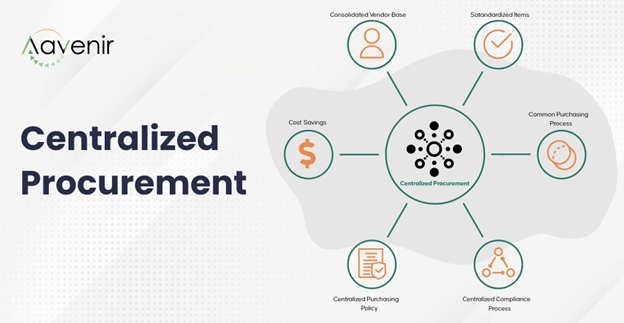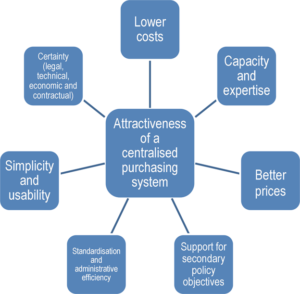Centralised procurement as a powerful health idea
Relevance
- GS Paper 2 Health, Government Policies & Interventions.
- GS Paper 3 Government Budgeting, Planning.
- Tags: #Centralisedprocurementofhealth #Health #Food.
Why in the news?
A recent study showed that pooled procurement by the central government when it comes to drug procurement can revolutionize the healthcare system in India
What is centralized purchasing?
- Centralized purchasing or procurement is a system in which one department manages the purchasing of goods and services for the entire organization. The purchasing department is usually located in the organization’s headquarters, where it handles the purchasing for all the branches of the firm.
- This department is headed by a purchasing manager who manages and tracks the materials that need to be procured and their quantities. Centralized purchasing is a perfect fit for enterprises that are not too geographically dispersed.
Advantages of centralized purchasing
With centralized purchasing, organizations can save money, operate more efficiently across the firm, and improve collaboration between employees. Let’s look at some of the advantages of centralized purchasing in detail:
Significant reduction in overhead expenses
- Payroll is the largest business expense, accounting for 68% of a company’s total overhead. With centralized purchasing, there is no need to employ individual purchasing managers for each location or department, and removing these duplicate staff positions saves the significant costs that accompany each one.
- If each department were to oversee its purchasing individually, it would also require more facilities, equipment, utility deposits, insurance policies—more investment in general. Centralized purchasing removes all of these requirements, reducing overhead expenses significantly.
Enhanced purchasing power and cost savings
- With centralized purchasing, firms can achieve greater cost savings since they have the information to assess the company’s needs and purchase materials in bulk. By eliminating spending by individual employees, duplicate orders and maverick spending can be curbed.
- Central purchasing teams can use their data on order histories and competing suppliers to find the best prices and negotiate volume-based deals. Consolidated purchasing means larger orders, which equals higher discounts, lower delivery charges, and more efficient use of staff time and storage space.
Cultivates strong supplier relationships
- Powerful supplier relationships are the by-product of having successful centralized purchasing teams. Staff on these teams learn to build and nurture supplier relationships and communicate effectively.
- Suppliers benefit from the relationship by gaining a better understanding of the firm’s business requirements and a fixed point of contact for resolving issues swiftly. This leads to on-time deliveries, fewer shortages, quality products, lower shipping costs, and substantial savings.
Efficient teamwork and collaboration
- Specialized purchasing teams operate more efficiently than distributed purchasing staff and benefit from having more clearly defined roles and better communication.
- This helps optimize the purchasing process since these teams work under uniformly established policies and guidelines with respect to procurement, business development, and vendor relationships.
- It also ensures that the standard quality of the materials is maintained and improves accountability and transparency.
In India
- Many countries and international organisations (including McDonald’s) have shown that a pooled buyer model for drug procurement addresses many issues that are related to price efficiency, stockouts and quality concerns.
- But for reasons that have remained mysterious for decades, the central government chooses to ignore the merits of pooled procurement when it comes to schemes such as the Central Government Health Scheme (CGHS), the Pradhan Mantri Jan Arogya Yojna (PMJAY) and the Employees’ State Insurance Scheme (ESI).
- Corporate hospital chains, on the other hand, are well aware of the benefits of pooled procurement.
- For years on end, they have conducted direct negotiations with pharmaceutical companies, and availed of significant discounts.
- Patients at these hospitals end up buying these drugs at maximum retail price of course, but that is another story.
- We cannot help but wonder why many more hospitals cannot team up to form buyers’ clubs, benefit from better bargaining power, and then, being not-for-profit institutions, pass on these cost savings to patients.
Limitations of centralized purchasing
Centralized purchasing offers considerable advantages, but when employed incorrectly it may also come with some disadvantages:
Not suitable for organizations with branches worldwide
Centralized purchasing might not be a good fit for firms that have branches spread out in many geographic locations. Here’s why:
- It is tedious to manage each location’s individual requirements — with different locations having different laws and tax regulations, trying to make centralized purchases for all the branches could run the risk of expensive violations
- Central purchasing makes it hard for firms to utilize local discounts.
- Expanding the purchasing team to manage multiple branches is counterproductive—it increases costs and the team may become too large to handle.
- It removes decision autonomy from local/regional managers, which can lead to poor job satisfaction.
- During emergency situations at the branch offices, strategic central purchasing decisions could lead to delays in getting essential items, compared to purchasing them locally.
Time-intensive approval and purchasing process
Routing all the purchasing decisions through the central team leads to slower processing. This is partly because of the approval process for requisition forms and purchase orders, and partly because of grouping purchases together for bulk discounts. This could cause delays in the delivery times for branch offices.
Conclusion
- Most CPOs, CFOs, and organizational leads would agree that finding the right purchasing model has always been a challenge.
- Poor purchasing models are one of the main reasons many firms are unable to control their costs—which adds to the pressure on the stakeholders to plan and structure the right model.
- Before you decide whether to implement centralized or decentralized procurement, It’s important to understand both models, their advantages, and their disadvantages. This will help you evaluate them to choose the right fit for your organization.
Source: The Hindu
Mains Question
“Besides being a moral imperative of a Welfare State, primary health structure is a necessary precondition for sustainable development.” Discus this line with respect to centralized procurement of food for health .





